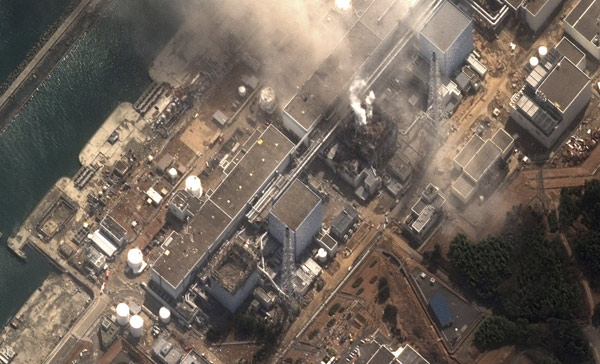Nuclear Meltdown
New explosion shakes stricken Japan nuclear plant
(Agencies)
Updated: 2011-03-15 09:07
 |
Large Medium Small |
FUKUSHIMA, Japan - A fresh explosion rocked a stricken Japanese nuclear power plant on Tuesday and some workers were ordered to leave the site, a sign that the situation may be getting more serious at the complex that was damaged by a massive earthquake and tsunami.
|
 The No 3 nuclear reactor of the Fukushima Daiichi nuclear plant at Minamisoma is seen burning after a blast following an earthquake and tsunami in this handout satellite image taken March 14, 2011. [Photo/Agencies] |
The operator of the Fukushima Daiichi complex said radiation levels around the site, immediately after the blast, the third there, were rising fast but still far from levels that local authorities say would cause large-scale radiation sickness.
Authorities are trying to prevent meltdowns in all three of the plant's nuclear reactors by flooding the chambers with sea water to cool them down.
"It was a hydrogen explosion. We are still assessing the cause and unsure whether the explosion was caused by damage to the suppression chamber," an official at the nuclear safety agency said. He did not have any more details.
The full extent of the destruction wreaked by Friday's massive quake and tsunami that followed it was still becoming clear, as rescuers combed through the region north of Tokyo where officials say at least 10,000 people were killed.
"It's a scene from hell, absolutely nightmarish," said Patrick Fuller of the International Red Cross Federation from the northeastern coastal town of Otsuchi.
Prime Minister Naoto Kan said Japan was facing its worst crisis since World War Two and, with the financial costs estimated at up to $180 billion, analysts said it could tip the world's third biggest economy back into recession.
The US Geological Survey upgraded the quake to magnitude 9.0, from 8.9, making it the world's fourth most powerful since 1900.
Car makers, shipbuilders and technology companies worldwide scrambled for supplies after the disaster shut factories in Japan and disrupted the global manufacturing chain.
Tokyo's Nikkei share average was down 5 percent shortly after opening on Tuesday, after falling more than 6 percent the previous day. Insurers' shares fell for a second day on Monday in London and New York, as world stocks slid to a six-week low.
"Not Chernobyl"
The fear at the Fukushima complex, 240 km (150 miles) north of Tokyo, is of a major radiation leak after the quake and tsunami knocked out cooling systems. The complex had already seen explosions at its No 1 and No 3 reactors on Saturday and Monday.
Jiji said Tuesday's explosion had damaged the roof and steam was rising from the complex. The news agency also reported some workers had been told to leave the plant -- a development one expert had warned beforehand could signal a worsening stage for the crisis.
The risk of a major radiation leak in Japan is subsiding as stricken nuclear reactors cool, but there will be major clean-up costs and three reactors will probably be written off, experts said on Monday.
The worst nuclear accident since the Chernobyl disaster in Ukraine in 1986 has drawn criticism that authorities were ill-prepared and revived debate in many countries about the safety of atomic power.
Switzerland put on hold some approvals for nuclear power plants and Germany said it was scrapping a plan to extend the life of its nuclear power stations. The White House said US President Barack Obama remained committed to nuclear energy.
Yukiya Amano, head of the International Atomic Energy Agency, said the reactor vessels of nuclear power plants affected by the disaster remained intact.
"The nuclear plants have been shaken, flooded and cut off from electricity," he told a news conference. But "the reactor vessels have held and radioactive release is limited."
Amano, a veteran Japanese diplomatic, added that a Chernobyl-style disaster was "very unlikely".
An explosion at the Soviet Chernobyl plant sent radioactive fallout across northern Europe.
Whilst the Fukuskima plant's No 1 and No 3 reactors both suffered partial fuel rod meltdowns, operator Tokyo Electric Power Co (TEPCO) had earlier said the No 2 reactor was now the biggest concern.
A sudden drop in cooling water levels when a pump ran out of fuel had fully exposed the fuel rods for a time, an official said. This could lead to the rods melting down and a possible radioactive leak.
TEPCO had resumed pumping sea water into the reactor early on Tuesday.
"This is nothing like a Chernobyl," said Murray Jennex, a nuclear expert at San Diego State University. "At Chernobyl you had no containment structure -- when it blew, it blew everything straight out into the atmosphere."
Nonetheless, the government warned those still in the 20-km (13-mile) evacuation zone to stay indoors. TEPCO said 11 people had been injured in the blast.
| 分享按钮 |



